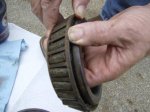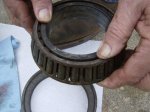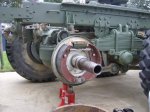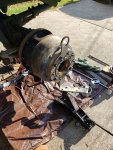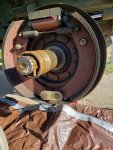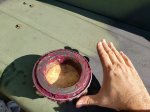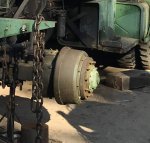Just a few quick questions that weren't quite answered by my thread searches or the TM.
There are several good Youtube videos on steering axle boots, hub and axle work but they're nearly all for the 939 series trucks with air brakes, which doesn't apply to me. Also, real life seems to contradict the TM in a few places.
1. In the 809 trucks, will the inner wheel bearing be captive in the back (inside) of the brake drum when I remove the drum, or will the bearing remain on the spindle when I pull the drum off? (TM/Youtube contradiction here) The TM makes it seem that the bearing is held in the drum by the grease seal but YT videos show the opposite...but those are 939's. I thought the grease seal would stay in the drum, trapping the wheel bearing inside?
2. In YT videos, I keep seeing people removing the whole knuckle when pulling the axles. The TM says to withdraw the axle from the steering knuckle, just be careful not to jostle the oil seal. Can I leave the knuckle on? What's the big "tell" if I have an oil seal leak? (I bought oil seals but I'm not replacing them if they're not leaking.)
3. I'm replacing the boots with new, zipper boots. My truck is a '71 so I figure I have a 50/50 chance of having the old style (Timken?) or newer universal joint style of CV joint. Can I view the CV joint when the boot is removed? Do I really have to pull the axles? There is no groaning, grinding or clicking noises from the front end. On the jack, the front wheels spin smooth and quiet, with no play.
I can tell you this- I have a (very recent) small split in an axle boot and it has slung some tired grease out onto the tire but there is not "oil" coming out and the oil level in the front axle is normal.
Basically, I'd like to re-pack the wheel bearings, inspect the brake shoes and hydraulic wheel cylinders, verify that I don't have an axle oil leak, peek at the CV joint from the backside, and put it all back together. The brakes work very well and I'd like to avoid opening the system by removing the brakes just to look at the CV joints if it's not strictly necessary.
Does this sound acceptable?
There are several good Youtube videos on steering axle boots, hub and axle work but they're nearly all for the 939 series trucks with air brakes, which doesn't apply to me. Also, real life seems to contradict the TM in a few places.
1. In the 809 trucks, will the inner wheel bearing be captive in the back (inside) of the brake drum when I remove the drum, or will the bearing remain on the spindle when I pull the drum off? (TM/Youtube contradiction here) The TM makes it seem that the bearing is held in the drum by the grease seal but YT videos show the opposite...but those are 939's. I thought the grease seal would stay in the drum, trapping the wheel bearing inside?
2. In YT videos, I keep seeing people removing the whole knuckle when pulling the axles. The TM says to withdraw the axle from the steering knuckle, just be careful not to jostle the oil seal. Can I leave the knuckle on? What's the big "tell" if I have an oil seal leak? (I bought oil seals but I'm not replacing them if they're not leaking.)
3. I'm replacing the boots with new, zipper boots. My truck is a '71 so I figure I have a 50/50 chance of having the old style (Timken?) or newer universal joint style of CV joint. Can I view the CV joint when the boot is removed? Do I really have to pull the axles? There is no groaning, grinding or clicking noises from the front end. On the jack, the front wheels spin smooth and quiet, with no play.
I can tell you this- I have a (very recent) small split in an axle boot and it has slung some tired grease out onto the tire but there is not "oil" coming out and the oil level in the front axle is normal.
Basically, I'd like to re-pack the wheel bearings, inspect the brake shoes and hydraulic wheel cylinders, verify that I don't have an axle oil leak, peek at the CV joint from the backside, and put it all back together. The brakes work very well and I'd like to avoid opening the system by removing the brakes just to look at the CV joints if it's not strictly necessary.
Does this sound acceptable?





